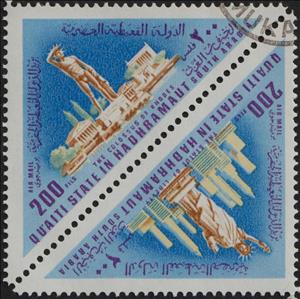Se-tenant: World Wonders of Antiquity and Modern Times (Hadhramaut, Qu'aiti (Shihr & Mukalla) 1968)
World Wonders of Antiquity and Modern Times (Hadhramaut, Qu'aiti (Shihr & Mukalla) 1968)
01 January (Hadhramaut, Qu'aiti (Shihr & Mukalla) ) within release World Wonders of Antiquity and Modern Times goes into circulation Se-tenant World Wonders of Antiquity and Modern Times face value 2*200 South Yemeni fils
| Se-tenant World Wonders of Antiquity and Modern Times in catalogues | |
|---|---|
| Michel: | Mi: AD-QSH 204A-205A |
| Yvert et Tellier: | Yt: AD-QSH PA25A-PA25B |
Se-tenant is square format.
The Colossus of Rhodes + The Statue of Liberty - NYCAlso in the issue World Wonders of Antiquity and Modern Times:
- Se-tenant - World Wonders of Antiquity and Modern Times face value 2*65;
- Se-tenant - World Wonders of Antiquity and Modern Times face value 2*200;
Se-tenant World Wonders of Antiquity and Modern Times it reflects the thematic directions:
Architecture (Latin architectura, from the Greek ἀρχιτέκτων arkhitekton "architect", from ἀρχι- "chief" and τέκτων "builder") is both the process and the product of planning, designing, and constructing buildings and other physical structures. Architectural works, in the material form of buildings, are often perceived as cultural symbols and as works of art. Historical civilizations are often identified with their surviving architectural achievements.
A building or edifice is a structure with a roof and walls standing more or less permanently in one place, such as a house or factory. Buildings come in a variety of sizes, shapes and functions, and have been adapted throughout history for a wide number of factors, from building materials available, to weather conditions, to land prices, ground conditions, specific uses and aesthetic reasons. Buildings serve several needs of society – primarily as shelter from weather, security, living space, privacy, to store belongings, and to comfortably live and work. A building as a shelter represents a physical division of the human habitat (a place of comfort and safety) and the outside (a place that at times may be harsh and harmful).
A mausoleum is an external free-standing building constructed as a monument enclosing the burial chamber of a deceased person or people. A mausoleum without the person's remains is called a cenotaph. A mausoleum may be considered a type of tomb, or the tomb may be considered to be within the mausoleum.
A monument is a type of structure that was explicitly created to commemorate a person or event, or which has become relevant to a social group as a part of their remembrance of historic times or cultural heritage, due to its artistic, historical, political, technical or architectural importance. Examples of monuments include statues, (war) memorials, historical buildings, archaeological sites, and cultural assets. If there is a public interest in its preservation, a monument can for example be listed as a UNESCO World Heritage Site. The Palgrave Encyclopedia of Cultural Heritage and Conflict gives the next definition of monument:
A statue is a free-standing sculpture in which the realistic, full-length figures of persons or animals are carved or cast in a durable material such as wood, metal or stone. Typical statues are life-sized or close to life-size. A sculpture that represents persons or animals in full figure, but that is small enough to lift and carry is a statuette or figurine, whilst those that are more than twice life-size are regarded as colossal statues.
The United Nations Educational, Scientific and Cultural Organization (UNESCO; pronounced /juːˈnɛskoʊ/) is a specialized agency of the United Nations (UN) with the aim of promoting world peace and security through international cooperation in education, arts, sciences and culture. It has 194 member states and 12 associate members,as well as partners in the non-governmental, intergovernmental and private sector. Headquartered in Paris, France, UNESCO has 53 regional field offices and 199 national commissions






